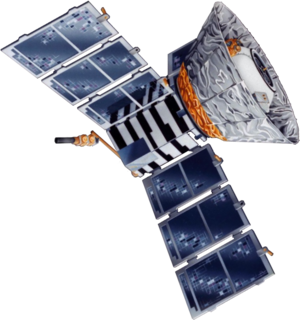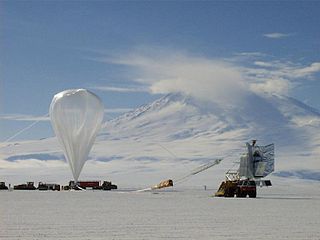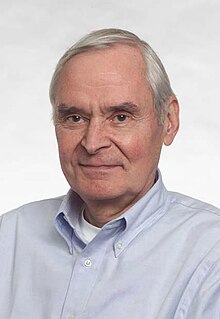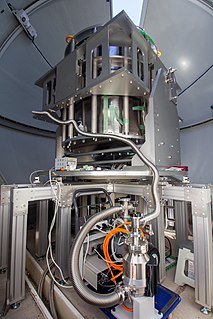
In Big Bang cosmology the cosmic microwave background is electromagnetic radiation that is a remnant from an early stage of the universe, also known as "relic radiation". The CMB is faint cosmic background radiation filling all space. It is an important source of data on the early universe because it is the oldest electromagnetic radiation in the universe, dating to the epoch of recombination when the first atoms were formed. With a traditional optical telescope, the space between stars and galaxies is completely dark. However, a sufficiently sensitive radio telescope shows a faint background noise, or glow, almost uniform, that is not associated with any star, galaxy, or other object. This glow is strongest in the microwave region of the radio spectrum. The accidental discovery of the CMB in 1965 by American radio astronomers Arno Penzias and Robert Wilson was the culmination of work initiated in the 1940s, and earned the discoverers the 1978 Nobel Prize in Physics.
The Greisen–Zatsepin–Kuzmin limit (GZK limit) is a theoretical upper limit on the energy of cosmic ray protons traveling from other galaxies through the intergalactic medium to our galaxy. The limit is 5×1019 eV (50 EeV), or about 8 joules (the energy of a proton travelling at ≈ 99.99999999999999999998% the speed of light). The limit is set by the slowing effect of interactions of the protons with the microwave background radiation over long distances (≈ 160 million light-years). The limit is at the same order of magnitude as the upper limit for energy at which cosmic rays have experimentally been detected, although indeed some detections appear to have exceeded the limit, as noted below. For example, one extreme-energy cosmic ray, the Oh-My-God Particle, which has been found to possess a record-breaking 3.12×1020 eV (50 joules) of energy (about the same as the kinetic energy of a 95 km/h baseball).

The Cosmic Background Explorer, also referred to as Explorer 66, was a NASA satellite dedicated to cosmology, which operated from 1989 to 1993. Its goals were to investigate the cosmic microwave background radiation of the universe and provide measurements that would help shape our understanding of the cosmos.

Observational cosmology is the study of the structure, the evolution and the origin of the universe through observation, using instruments such as telescopes and cosmic ray detectors.

The Cosmic Background Imager was a 13-element interferometer perched at an elevation of 5,080 metres at Llano de Chajnantor Observatory in the Chilean Andes. It started operations in 1999 to study the cosmic microwave background radiation and ran until 2008.

In astronomy and observational cosmology, the BOOMERanG experiment was an experiment which measured the cosmic microwave background radiation of a part of the sky during three sub-orbital (high-altitude) balloon flights. It was the first experiment to make large, high-fidelity images of the CMB temperature anisotropies, and is best known for the discovery in 2000 that the geometry of the universe is close to flat, with similar results from the competing MAXIMA experiment.

David Todd Wilkinson was a world-renowned pioneer in the field of cosmology, specializing in the study of the cosmic microwave background radiation (CMB) left over from the Big Bang.

Llano de Chajnantor Observatory is the name for a group of astronomical observatories located at an altitude of over 4,800 m (15,700 ft) in the Atacama Desert of northern Chile. The site is in the Antofagasta Region approximately 50 kilometres (31 mi) east of the town of San Pedro de Atacama. The exceptionally arid climate of the area is inhospitable to humans, but creates an excellent location for millimeter, submillimeter, and mid-infrared astronomy. This is because water vapour absorbs and attenuates submillimetre radiation. Llano de Chajnantor is home to the largest and most expensive astronomical telescope project in the world, the Atacama Large Millimeter Array (ALMA). Llano de Chajnantor and the surrounding area has been designated as the Chajnantor Science Reserve by the government of Chile.

Charles L. Bennett is an American observational astrophysicist. He is a Bloomberg Distinguished Professor, the Alumni Centennial Professor of Physics and Astronomy and a Gilman Scholar at Johns Hopkins University. He is the Principal Investigator of NASA's highly successful Wilkinson Microwave Anisotropy Probe (WMAP).
RELIKT-1 was a Soviet cosmic microwave background anisotropy experiment launched on board the Prognoz 9 satellite on 1 July 1983. It operated until February 1984. It was the first CMB satellite and measured the CMB dipole, the Galactic plane, and gave upper limits on the quadrupole moment.
The Degree Angular Scale Interferometer (DASI) was a telescope installed at the U.S. National Science Foundation's Amundsen–Scott South Pole Station in Antarctica. It was a 13-element interferometer operating between 26 and 36 GHz in ten bands. The instrument is similar in design to the Cosmic Background Imager (CBI) and the Very Small Array (VSA). In 2001 The DASI team announced the most detailed measurements of the temperature, or power spectrum of the Cosmic microwave background (CMB). These results contained the first detection of the 2nd and 3rd acoustic peaks in the CMB, which were important evidence for inflation theory. This announcement was done in conjunction with the BOOMERanG and MAXIMA experiment. In 2002 the team reported the first detection of polarization anisotropies in the CMB.

QUaD, an acronym for QUEST at DASI, was a ground-based cosmic microwave background (CMB) polarization experiment at the South Pole. QUEST was the original name attributed to the bolometer detector instrument, while DASI is a famous CMB interferometry experiment credited with the first detection of CMB polarization. QUaD used the existing DASI mechanical infrastructure but replaced the DASI interferometric array with a bolometer detector at the end of a cassegrain optical system. The mount has housed the Keck Array since 2011.
ACBAR was an experiment to measure the anisotropy of the Cosmic microwave background. It was active 2000-2008.
QMAP was a balloon experiment to measure the anisotropy of the Cosmic microwave background. It flew twice in 1996, and was used with an interlocking scan of the skies to produce cosmic microwave background (CMB) maps.

QUIET was an astronomy experiment to study the polarization of the cosmic microwave background radiation. QUIET stands for Q/U Imaging ExperimenT. The Q/U in the name refers to the ability of the telescope to measure the Q and U Stokes parameters simultaneously. QUIET was located at an elevation of 5,080 metres at Llano de Chajnantor Observatory in the Chilean Andes. It began observing in late 2008 and finished observing in December 2010.

Cosmic background radiation is electromagnetic radiation from the Big Bang. The origin of this radiation depends on the region of the spectrum that is observed. One component is the cosmic microwave background. This component is redshifted photons that have freely streamed from an epoch when the Universe became transparent for the first time to radiation. Its discovery and detailed observations of its properties are considered one of the major confirmations of the Big Bang. The discovery of the cosmic background radiation suggests that the early universe was dominated by a radiation field, a field of extremely high temperature and pressure.

The Cosmology Large Angular Scale Surveyor (CLASS) is an array of microwave telescopes at a high-altitude site in the Atacama Desert of Chile as part of the Parque Astronómico de Atacama. The CLASS experiment aims to improve our understanding of cosmic dawn when the first stars turned on, test the theory of cosmic inflation, and distinguish between inflationary models of the very early universe by making precise measurements of the polarization of the Cosmic Microwave Background (CMB) over 65% of the sky at multiple frequencies in the microwave region of the electromagnetic spectrum.
Suzanne T. Staggs is an American physicist who is currently the Henry DeWolf Smyth Professor of Physics at Princeton University. Staggs has led the development of numerous cosmic microwave background experiments and is currently the principal investigator (PI) of the Atacama Cosmology Telescope (ACT) and founding member of the Simons Observatory (SO). In 2020, Staggs was elected into the National Academy of Sciences.

GroundBIRD is an experiment to observe the cosmic microwave background at 145 and 220GHz. It aims to observe the B-mode polarisation signal from inflation in the early universe. It is located at Teide Observatory, on the island of Tenerife in the Canary Islands.












